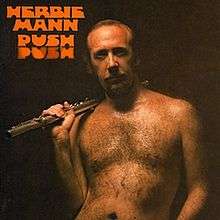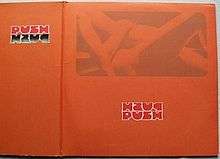Push Push (album)
| Push Push | ||||
|---|---|---|---|---|
 | ||||
| Studio album by Herbie Mann | ||||
| Released | July 1, 1971 | |||
| Genre | Crossover jazz, jazz fusion, soul jazz, jazz-funk, rhythm and blues | |||
| Length | 43:22 | |||
| Label | Atlantic/Cotillion Records/Embryo Records | |||
| Producer | Arif Mardin | |||
| Herbie Mann chronology | ||||
| ||||
| Professional ratings | |
|---|---|
| Review scores | |
| Source | Rating |
| Allmusic | |
| The Rolling Stone Jazz Record Guide | |
Push Push is a 1971 instrumental album by jazz flautist Herbie Mann, on his Embryo Records label with Atlantic, which features rock guitarist Duane Allman. The record explored a range of popular genres, such as R&B, rock and funk music to create what Allmusic calls a "generally appealing, melodic and danceable" album with an "impressive crew of musicians."[3][4]
Personnel
Other performers on the album included Cornell Dupree (guitar), David Spinozza (guitar) (incorrectly credited as David Spinoza), Gene Bianca (harp), Richard Tee (piano, electric piano, organ), Chuck Rainey, Jerry Jemmott, Donald "Duck" Dunn (bass), Bernard Purdie, Al Jackson, Jr. (drums), and Ralph MacDonald (percussion). Guitar solos were by Duane Allman, except on "Man's Hope", which was performed by David Spinozza. The engineer was Jimmy Douglass and the producer was Arif Mardin.
Track listing
- "Push Push" (Herbie Mann)
- "What's Going On" (Renaldo Benson, Alfred Cleveland, Marvin Gaye)
- "Spirit In The Dark" (Aretha Franklin)
- "Man's Hope" (traditional, arrangement by Herbie Mann, based on "Hatikvah")
- "If" (David Gates)
- "Never Can Say Goodbye" (Clifton Davis)
- "What'd I Say" (Ray Charles)
- "Funky Nassau" (CD bonus track)
Jacket design and notes

The original cover, by Joel Brodsky, features an apparently nude Mann from the waist up, holding a flute resting on his shoulder. The album had the second "PUSH" die cut out, with the gatefold featuring a textured (flocked) duotone orange and black print of two torsos engaged in missionary style intercourse (no explicit content). The die cut reveals a small, unrecognizable portion of the print. The album's images generated controversy at the time.[5] Later printings excluded the gatefold print, or eliminated the gatefold format entirely. Liner notes by Mann include: "P.S., Marvin Gaye's album What's Going On is the best album of the year!"
References
- ↑ Allmusic review
- ↑ Swenson, J. (Editor) (1985). The Rolling Stone Jazz Record Guide. USA: Random House/Rolling Stone. p. 130. ISBN 0-394-72643-X.
- ↑ Push Push (CD) at fye.com
- ↑ Push, Push, Herbie Mann, vinyl LP, Embryo Records/Cotillion, division of Atlantic Recording Company, 1971, stereo/SD 532
- ↑